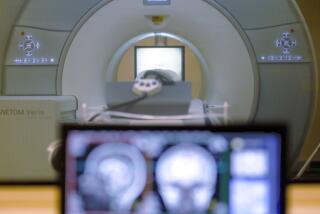A patient’s obesity can get in doctors’ way
“House,” Fox, Oct. 7. Episode: “Que Sera, Sera.”
The premise: A 600-pound man, George Hagel, is brought into the hospital in a coma. Dr. Gregory House and his team of diagnosticians are stumped as they consider Pickwickian syndrome (obesity hypoventilation syndrome), a stroke, a parasite, a sexually transmitted disease and diabetes.
House tries to force Hagel to drink sugar water to rule out diabetes (a glucose tolerance test). Dr. Allison Cameron orders an MRI of the brain, even though Hagel is at least 150 pounds too heavy for the machine. (The million-dollar piece of equipment breaks when he wakes from his coma and begins to thrash around.)
Cameron keeps Hagel from being discharged from the hospital by slipping him the antiseizure drug phenytoin, which causes him to stagger and crash through a glass wall. When cerebrospinal fluid is needed, Dr. Eric Foreman decides that the patient is too obese for a routine lumbar puncture, so he takes Hagel to the operating room and inserts a needle into the back of his brain. When he does this, Hagel goes blind.
Finally, House notices that Hagel’s fingers are deformed (known as “clubbing”), and orders X-rays, which confirm a paraneoplastic syndrome that House believes is associated with small cell cancer of the lung -- which would explain the coma and blindness. The diagnosis is confirmed by bronchoscopy. Hagel will be treated with radiation but is only expected to live a few months.
The medical questions: Does extreme obesity interfere with obtaining essential medical tests such as an MRI and lumbar puncture? Can small cell carcinoma of the lung cause a coma and blindness and damage the fingertips? Is the prognosis as dismal as suggested?
The reality: A morbidly obese patient presents a series of unique diagnostic problems. Scanners have weight limits -- 450 pounds in many cases -- limiting imaging options. Because of Hagel’s mass of fatty tissue, it would also be extremely difficult to place a spinal needle into his lumbar canal, the optimal place to draw fluid in a spinal tap. Ultimately, a neurosurgeon might be needed to place the needle in the back or the neck. But the needle would not generally be placed in the brain, and blindness as a direct result of this rare procedure is unlikely.
A thorough physical examination is especially crucial when imaging tests are not an option. The clubbing of Hagel’s fingertips, which is much more frequently associated with large cell cancer of the lung rather than the small cell type, should have been discovered when he was admitted.
Although small cell cancer of the lung is extremely aggressive and the prognosis is poor (five-year survival is less than 6%), the response to treatment is not entirely predictable. Four percent of patients develop paraneoplastic neurological syndrome, in which cancer cells release antibodies against the brain’s nerve cells.
As in Hagel’s case, these antibodies can attack the limbic system (the emotional center responsible for attention and memory), leading to confusion, memory loss and seizures, and the cerebellum, causing his unsteady gate. Rapid vision loss, which is indeed possible, can be caused by antibodies directed against retinal proteins.
Lest patients think doctors can make decisions with impunity, they should know that the show’s greatest foray into fiction is in the doctors’ behavior. House’s attempt to force the patient to drink sugar water and Cameron’s drugging him are nothing short of assault and battery. In reality, both doctors should -- and likely would -- be charged with criminal offenses and lose their licenses to practice medicine.
Dr. Marc Siegel is an internist and an associate professor of medicine at New York University’s School of Medicine. He is also the author of “False Alarm: The Truth About the Epidemic of Fear.” Here, he explains the medical facts behind the media fiction. He can be reached at marc@doctorsiegel.com.
More to Read
The complete guide to home viewing
Get Screen Gab for everything about the TV shows and streaming movies everyone’s talking about.
You may occasionally receive promotional content from the Los Angeles Times.






